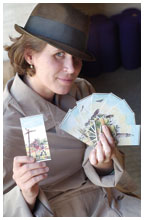
|
November 22, 2006: From the Editor
Dana Sheridan dons private-eye garb to demonstrate myriorama cards, a parlor game popular in the 1900s. (Mark Czajkowski/The Princeton Packet) |
Professor Uli Knoepflmacher *61, the William and Annie S. Paton Foundation Professor of Ancient and Modern Literature and the subject of our “Moment With” interview in this issue, laments that many English professors have little respect for children’s literature, the subject of a popular course he teaches. Nonetheless, one place at Princeton has a unique commitment to children’s texts: the Cotsen Children’s Library, a haven for children and scholars alike.
Last week, the Cotsen library — a gift from Lloyd E. Cotsen ’50 — held an international conference on children’s literature “from its beginnings to the present day,” said the curator, Andrea Immel. Knoepflmacher was on the agenda, along with other experts on children’s poetry, fantasy, and “humor and subversion,” among other topics.
While Cotsen’s annual conferences and support for research illustrate the library’s intellectual side, the place has something of a split personality. The walls are lined with rare editions kept under lock and key, available by appointment with the curator. But most of Cotsen’s gallery is devoted to children, with a two-story artificial bonsai tree set up for comfy reading, favorite kids’ books spread around the room, a small puppet theater, and tables readied for book-related art projects and presentations. On a recent day, the most prominent visitor was not a scholar gingerly handling a rare text, but a preschool boy intent on presenting a puppet show for anyone in earshot.
The library, which is in Firestone Library, has long offered community-outreach programs. This fall, the Cotsen staff decided that since not all schools could come to the library, the library would go to the schools. The result is a new “Cotsen in the Classroom” program, in which Cotsen’s education and outreach coordinator, Dana Sheridan, visits local elementary classrooms with one of three trunks full of library materials.
One trunk introduces children to Beatrix Potter not only as the author of Peter Rabbit, but as a naturalist who sketched fossils, fungi, plants, and animals; another turns the students into detectives who must get clues from “rare” documents; a third brings the slates, primers, and copybooks that schoolchildren used in the 1700s. With the colonial trunk, Sheridan wears a costume that transforms her into an 18th-century schoolmarm: “As I get dressed, I take the children back through time.”
Why do it? All the materials in the trunks are reproductions of items found in Cotsen’s collections — collections that, as Sheridan said, “are wonderful, but are not accessible to the general public, or to children.” Each trunk, she said, “shows kids something that they might not know otherwise, something that can really interest them.”
It’s an investment, and one that could have a big payoff — not just for children’s literature, but for the kids who, thanks to Sheridan and the Cotsen library, are prompted to read it.
![]()
![]()
Marilyn H. Marks *86
mmarks@princeton.edu

